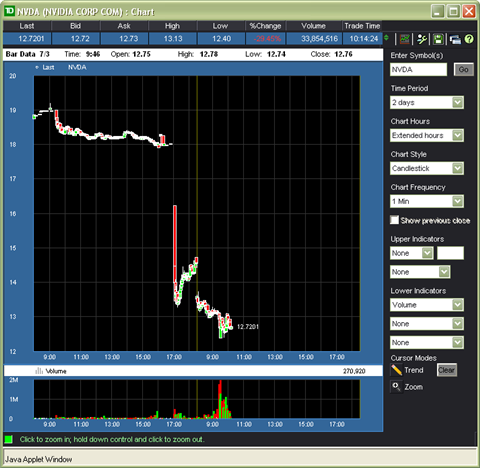Nvidia whacked over defective notebook chips; Offers driver to keep processors cool

Updated: Nvidia said its fiscal second quarter revenue will fall well short of targets because of weak demand, pricing pressure from AMD's ATI and a faulty graphics processors on older notebook systems. In an SEC filing, the company said it is offering a driver that keeps fans running to relieve stress on the faulty chips in the field.
The company said after the bell Thursday that second quarter revenue is expected to by $875 million to $950 million (statement, Techmeme). The company reported first quarter revenue of $1.15 billion and was projecting the second quarter to be a seasonally average one with a revenue decline of about 5 percent to $1.09 billion. Wall Street was expecting second quarter earnings of 34 cents a share.
Nvidia cited "end-market weakness around the world, the delayed ramp of a next generation MCP, and price adjustments of our GPU products to respond to competitive products." It's unclear which of those factors contributed the most to the shortfall.
Nevertheless, Nvidia's quarter unraveled dramatically. On May 8, CEO Jen-Hsun Huang said:
"We have no reason to believe that Q2 will be anything other than seasonal. Seasonal to us means a decline of 5% plus or minus."
It's a different story today. Nvidia said that it will take a $150 million to $200 million charge in the quarter for warranty, repair, return and replacement costs for high failure rates for its previous generation chips. Nvidia blamed the faulty chips on "weak die/packaging material set in certain versions of its previous generation GPU and MCP products used in notebook systems." These graphic chips are failing in systems already in the field. Nvidia was sketchy about what systems are affected, but added that it has begun discussions with its supply chain about the material used in the chips. It is also seeking insurance coverage.
Nvidia's statement was a bit vague on the matter, but the SEC filing gave a little more detail on the problem. Overall, it sounds like the company is still investigating as well as sorting out what models specifically are impacted. In any case, Nvidia needs to detail what models are impacted by this problem pronto.
Overheating is the big issue. In the filing Nvidia said (emphasis added):
The previous generation MCP and GPU products that are impacted were included in a number of notebook products that were shipped and sold in significant quantities. Certain notebook configurations of these MCP and GPU products are failing in the field at higher than normal rates. While we have not been able to determine a root cause for these failures, testing suggests a weak material set of die/package combination, system thermal management designs, and customer use patterns are contributing factors. We have developed and have made available for download a software driver to cause the system fan to begin operation at the powering up of the system and reduce the thermal stress on these chips. We have also recommended to our customers that they consider changing the thermal management of the MCP and GPU products in their notebook system designs. We intend to fully support our customers in their repair and replacement of these impacted MCP and GPU products that fail.
(Note: I'm trying to find a Nvidia advisory for this download, but the drivers are based on the model of chip. The rub: Nvidia hasn't detailed what systems are impacted by this glitch. In a nutshell, this driver may be available, but good luck finding it on Nvidia's site--it appears to be an OEM first strategy).
Update: Adrian Kingsley-Hughes has more on the issue. He notes that there have been problems recently with Dell's m1330 and m1530 related to overheating. These machines are powered by the GeForce 8400M GS. It's not confirmed, but it's a trail to follow. Also see this driver download and this one from Dell on July 1.
In any case, Nvidia's timing is terrible. For starters, Nvidia is warning in a market that's unforgiving. How unforgiving? Check out this carnage. And analysts are lowering Nvidia's price targets and cutting estimates at a rapid clip.
On the competitive front, Nvidia's stumble would appear to be an opening for AMD's ATI, which is also likely to be the rival putting on the pricing pressure that helped ding margins. ATI and Nvidia have both launched new products, but ATI has gone with a more moderate price approach that appears to be resonating.
In a statement, Huang said:
"Although the failure appears related to the combination of the interaction between the chip material set and system design, we have a responsibility to our customers and will take our part in resolving this problem. The GPU has become an increasingly important part of the computing experience and we are seeing more interest by PC OEMs to adopt GPUs in more platforms. Recognizing that the GPU is one of the most complex processors in the system, it is critical that we now work more closely with notebook system designers and our chip foundries to ensure that the GPU and the system are designed collaboratively for the best performance and robustness."
More graphic chip coverage:
- Radeon HD 4850 - Another GPU that fails to keep up with the aging 8800 GTS
- NVIDIA unveils the GeForce GTX 200 series
- ATI Catalyst 8.5 brings improvements and performance boost for some games
- NVIDIA launches the ‘best performing GPU on the planet’
- AMD announces Puma laptop platform, Mobile Radeon 3800 GPU
- AMD makes its notebook move; Puma goes live
